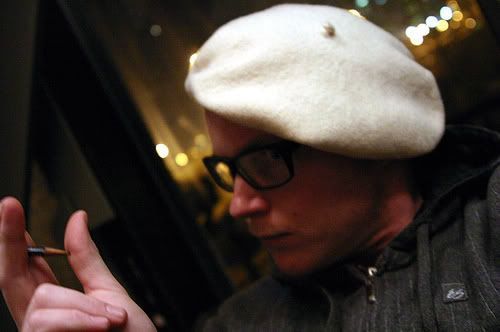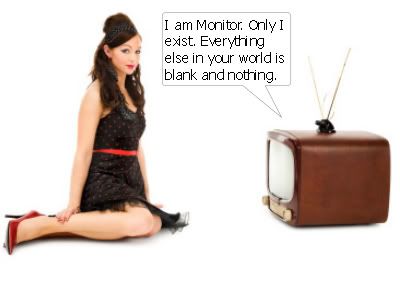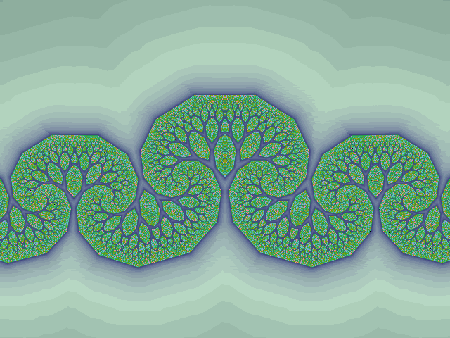
Snake Tree by Jim Muth
Fractal of the Day: 4-12-97
I'll try to post a different image every day, until I make my point that complicated formulas are not necessary for new and unusual fractals.
It appears that Jim Muth has yet to make his point, although, come April, he will have been posting his fractals and writing about them for twelve years. His encyclopedic Fractal of the Day (FOTD) site, graciously hosted by Paul N. Lee, is a treasure trove of not only fractal art, but also Muth's thoughts on the passing parade of the fractal art scene since 1997.
In a way, Muth's FOTD dispatches remind me a bit of Garrison Keillor's news from Lake Wobegon, but FOTD is spiced with more serious philosophy and contains much less Midwestern folksiness. The feels-like-home trappings are not unlike the world found at A Prairie Home Companion, for Muth updates regular readers with daily fractal weather reports and tales on how the fractal cats passed each day. But it's the images, their parameter files, and Muth's wide-ranging musings on art, philosophy, mathematics, politics, and fractal fads and fashion that endure and continue to reward with repeated readings.
If you've never tried blogging, you might easily underestimate Muth's ongoing, monumental achievement. I feel fortunate if I can come up with something to say every week or two. But Muth's been plugging away providing daily communiqués from Fractal Central since 1997 (over 4000 posts to date). Muth is unquestionably the original fractal blogger -- blogging long before the term blog had even been coined. He is fractal art's Boswell, our Scheherazade whose stories keep himself -- and, by extension, us and our art form -- alive. Truly, Muth's accomplishment is nothing less than a continuing diorama that captures the zeitgeist of fractal art.
Let's drop in here and there and see what's up...
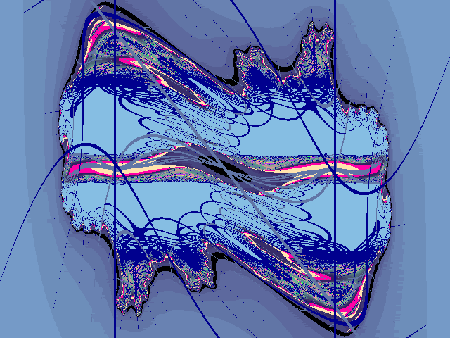
Pollock by Jim Muth
Fractal of the Day: 9-28-97
Fractal visionaries:
Today's prize-winner fractal is named in honor of that not quite so famous American abstract artist, J. Pollock. The resemblance to the paint drippings which made him famous is quite apparent.
I achieved such an effect by taking a nondescript Rectangular plane fractal and redoing it with the inside fill set to epsilon cross. I'm not sure how this option achieves its effects. I think it colors the image according to whether the points' orbits come closest to the real or imag axis.
Until recently I had never used this option, considering such a fancy fill method artificial, but I have now had second thoughts about fractals. There is no such thing as a "natural" or "pure" fractal other than the bare formula. And since a natural fractal doesn't exist, it makes no sense to try to maintain fractal purity. And since I no longer must try to keep my fractals pure, I will be able to use the entire range of Fractint's coloring options without compunction.
Muth is ahead of the curve on several fronts here. First, he recognized the connection between Pollock's action paintings and fractal geometry before doing so was fashionable. Second, he put the old post-processing fracas to rest almost before it even started. Once any action is taken beyond the formula, including simple image generation, every fractal is already tainted. So color away and break out the filters. Photoshop, here we come. And, for UFers, feel free to pancake layers with wild abandon. Just be sure to leave off any self-congratulatory and hypocritical notations like 100 layers -- No post-processing. Muth grasped early on that UF masking and layering were unnatural before UF users even started tweaking.
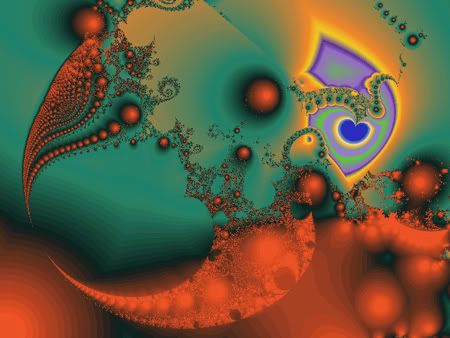
Diabolically Clever by Jim Muth
Fractal of the Day: 5-18-99
Fractal enthusiasts:
I received an e-mail today from one of my readers, commenting that the FOTD is taking on a dark aspect. Well, I guess it is. But I rather enjoy darkness and daring to think the deep, dark thoughts that others try to keep submerged. And current events are doing nothing to push my darker thoughts aside, as today's FOTD shows.
Today's fractal plumbs the deepest depths of darkness -- right down to the underworld itself. The picture exemplifies the darkness. I have named it "Diabolically Clever" for no reason other than its resemblance to the fiery pit. It was created with my MandNewt05 formula, using the <atanh> function to initialize Z and the bof60 inside fill to supply the colors, which were juiced up just a tiny bit in Photoshop 5.0.
The scene is one of utter chaos -- one of the most disorganized fractals I have ever found. No two areas show the same character. The lower half, with its blacks and reds, seems to be reflecting the smoke and fires of the great pit below, while the greenish upper half gives only a hint of the celestial blue glories that lie in that direction. I suspect that if the picture extended a few inches lower, the very demons of Hades would be seen screaming and shrieking as they hot-footed over the coals.
Most of the left part is occupied by a strange, ghostly, almost-circular skeleton arc, with Mandel bud-like indentations. The two sides of this arc are of totally different character. A geometric spot of brighter color toward the upper right of the picture does little to relieve the gloominess of the rest of the scene. Actually, this spot of brightness and color hints at some vague familiar memory from long ago that I cannot quite recall.
[...]
The weather here today at Fractal Central was far more heavenly than the fractal. The sapphire blue sky, cottony clouds, and temperature of 72F 22C made it a perfect day to do anything under the sun. I chose fractaling, which I was not quite under the sun when I did it, but within sight of the sun.
Now the time to close down the fractal machine has come. But I'll be here again tomorrow with another diabolically clever fractal and if I get myself out of the doldrums, a bit of philosophy. Until then, take care, and only my humility prevents me from admitting how great a fractal artist I am. That is if fractals are art.
This post really shows the dimensions of Muth's talents. For one, it reveals how adept he is at understanding and breaking down his own work. This is seen both in his explanation on the fractal's disorganization, and in his observations as to how the color gradations correspond to moods. For another, Muth's courage to buck the prevailing fractals-as-eyecandy aesthetic is clearly stated and clarified. If fractals are indeed art, a notion that he jabs with mock humility at the post's end, then they are capable of considerably more than just being pretty wallpapers. Art embodies all of our experiences and moods; it is not necessarily limited to "the better angels of our nature." Muth is clearly jabbing us in the ribs as he concludes. His willingness to dare "to think the deep, dark thoughts" proves he believes that fractals are art.
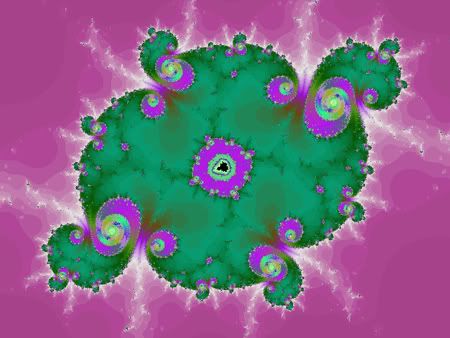
Rising Discord by Jim Muth
Fractal of the Day: 10-19-99
Fractal enthusiasts and visionaries:
Green and magenta just don't blend harmoniously. They create a chromatic discord. But sometimes discords can add to the artistic value of a work of art, so I let today's color palette stand in its discord. Combined with the writhing, twisting elements that surround the central midget, the picture fully deserves the name "Writhing Discord".
The picture (as indeed are all my pictures) is in the spirit of a fractal of 10 years ago -- a single-layer image that would have been awesome in the days when people were just discovering fractals. Sometimes when I sample the images posted to ABPF, I wonder why I bother calling myself a fractal artist at all. It's clear to me that those creating the images I see there are doing something far more artistic than my humble and not very serious efforts.
Actually, I have never outgrown the awe I felt when I read that first article about the Mandelbrot set over 15 years ago. I am an explorer, a fractal photographer who tries to faithfully record the things he finds in the abstract world of fractals. If the things I find do occasionally make art, so much the better.
Unlike some fractal artists I've known, Muth is comfortable in his own skin. He neither tries to defend his approach, nor does he go out of his way to attack the artistic means and preferences of others. Muth was prescient to comprehend that our art form might split between those who lean to math and those who lean to art. These two camps have fundamentally different aims, contrasting mindsets, and dissimilar aesthetics. But Muth knows what he wants. The looming schism he sees on the fractal newsgroup does not threaten him but is merely a new way of using fractals for self-expression. Maybe he feels settled because he's never lost the awe (have you?), and he's still busy recording, still trying to get each fresh discovery right. I suspect that's why he continues to blog, too. Each successive FOTD is another chance for novel discoveries. And, since he often does make art, "so much the better" -- for us, his gentle readers and viewers.
And, by the way, you owe it to yourself to read the rest of this entry for Muth's sublime philosophical discussion of life before birth and life after death.
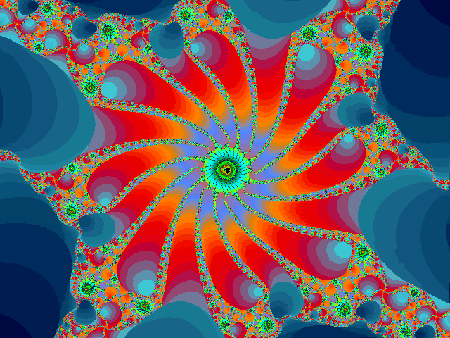
Fractal of the Day for March 15th by Jim Muth
Fractal of the Day: 3-15-00
Fractal enthusiasts and visionaries:
I see that the FracTint vs UltraFractal debate has heated up again. Of course, it's no secret that I'm a Fractint user, and have been since version 2.1. I still have that early version stashed away in a remote directory of my old 8mhz 80286 machine. The executable file of that ancient version is named fract386.exe. The file size is a whopping 32,541 bytes, and the date is 10-23-88 -- 9:06p. Things have come a long way since then.
Actually, I feel that the big debate is a bit overwrought. I see Fractint and UF as complementing each other rather than competing, with Fractint emphasizing the mathematical aspect of fractals, and UF with its multiple layers emphasizing the artistic aspect. My view is pretty near the middle in this debate, but if asked to choose a side, I would side with the Stone-Soupers, since I am more interested in the math than the art.
Today's fractal comes from the formula 4Z^(-2)-5Z^(-1)+C. The area in which the scene lies consists of features that resemble elephants with heads on both ends. The parent fractal is rather interesting, with a train of Mandeloid fragments shrinking to infinity. This fractal definitely deserves the further investigation that I will give it tomorrow.
I was unable to think of a name for today's picture, and finally settled on the technical description "FOTD for March 15" as the name. The image, which originally was a bit drab, was given post-processing in a graphics program to liven it.
Ah, yes. The never-ending generator wars. Mine's bigger and brighter and faster than yours. The Fractint old schoolers vs.The Ultra Fractal cult vs. The XenoDream clan vs.The Apophysis conclave vs. The Chaos Pro and Fractal Explorer tribes vs. The Houses of Ferguson and Gintz vs.The lone wolf self-made programmers. Again, Muth is magnanimous and relatively non-judgmental here. He can see both sides but admits he falls more into the math camp. How ironic, though. I'd now consider UF to be more about the math (or, as Tim once noted, about the engineers) and a decision to export fractals to graphics programs to be a route that's more about the art. And, here, in a moment of historical recursion, Muth admits livening up his image in Photoshop. What goes round...
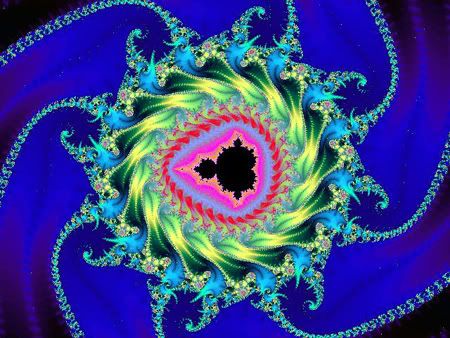
A Midget by Jim Muth
Fractal of the Day: 5-31-00
Fractal visionaries and enthusiasts:
The final FOTD for the month of May should feature a fractal worthy of the occasion. And indeed it does. Today's midget, to which I have given the simple, non-assuming name "A Midget", rates (IMO) a much-above-average 8 on my 1-to-10 scale of fractal worth.
Surprisingly enough, the image is another accident. When I entered the parameters, I had intended on combining Z^(-2) and Z^(-20), but for some reason I forgot the minus signs and inadvertently calculated -2(Z^2+Z^20)+(1/C). And this time I can't blame the cats.
But, as today's picture shows, the result was not bad. The formula draws a crooked fractal with a shrunken, crooked Mandelbrot set lurking near the upper left corner of the frame. The little M-set is fairly conventional, but it is surrounded by the fractal debris that breeds interesting midgets. When I saw this, I got out my mathematical microscope and went in search of these midgets.
[...]
The mathematical aspect of the midget is not exceptional; the coloring is what makes the scene. In fact I put so much effort into coloring this image that I actually feel I'm in danger of becoming a fractal artist. At this rate, you'll soon be seeing me creating fractals with something like multiple layers.
Of course, I'm jesting. I would never desecrate a fractal by dropping it on top of another image. As for transforms -- who knows. When I calculate 1/C instead of C, I'm already doing a transform. Maybe sometime in the future I will use more complex transforms, but for the foreseeable future it's fractal purity.
(In the sixth grade, Sister Theresa caught me staring at one of the girls, and told me to keep my thoughts pure. And now at this late date I'm finally starting to do it.)
Butthead: I'd like to desecrate something.
Beavis: Huh. Uhh. Snort. You said...desecrate.
Joseph Trotsky once called my work fractal vandalism. And, here, Muth takes a less-than-subtle potshot at the UF pancake patrol for desecration. Oh, well. No one's perfect. Because, after all, only one of them is wrong.
And I hate to say this, Jim, but Sister Theresa has already got the goods on you. You'll soon have stinging hands and be shuffling off to the confessional. Remember, Catholic sins can be committed in thought, word, and deed. Those cunning nuns had all the angles covered. If you think it, it's the same as doing it. Your thoughts while girl gawking were instantaneously impure -- and now your thoughts, still not kept in check, have turned to...layering. That word does have a kind of smutty, lusty connotation, doesn't it? Mask me, then layer me, baby. Ick. That sounds like something adults do in the privacy of their bedrooms. Bless me, father, for I have layered. If you know what I mean...
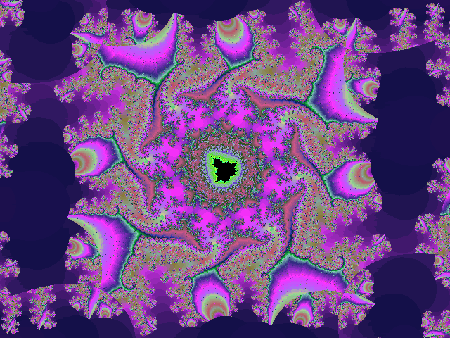
Pinkness by Jim Muth
Fractal of the Day: 8-12-00
Fractal visionaries and enthusiasts:
For today's average-quality fractal it's back to the formula -1Z^(-11)-11Z^(-1.1)+(1/C), with a bailout radius of 200. As I stated in yesterday's FOTD, this formula draws a most unusual fractal, which is too large to fit on the default screen, but is worth closer examination from one end to the other.
A prominent feature of this parent fractal is a large fan-shaped object. Today's scene with its unusual midget lies buried deep at the edge of this fractal fan, where chaos begins.
[...]
The fractal weather today was rather pleasant, with mostly sunny skies and a temperature of 86F (30C). The fractal cats approved of the conditions, and showed their approval by spending most of the afternoon in the yard. In the evening, when the mosquitoes got too thick, they came indoors.
I did a bit of philosophical pondering this afternoon on the question of whether fractals are art, a topic that has been keeping the UltraFractal list so busy these past few days. Of course it's a futile topic, since no definite answer is possible, but it never fails to bring a flood of comments.
Why, I wondered, does this one topic bring such activity every time it arises? Sometimes I feel that the UF list exists only as a forum for fractal artists to re-assure each other that they are indeed creating real art. I had assumed that fractals are art if that's what the creator intends, and that they are mathematical curiosities if this aspect is emphasized. In my case, I consider my FOTD's to lie in a grey area somewhere between art and math.
IMO, It is the attitude of the creator at the time of creation that determines whether an image is simply an illustration of a pre-existing object or a newly-created work of art. If we want our fractal images to be art, then they are art. We don't need the rest of the world reassuring us that we have indeed created a work of art. If we want our fractals to be illustrations of the amazing things numbers can do, then they are such illustrations. If we want our pictures to be a bit of both, as I do, then they are a blend of art and mathematics.
On the other hand, I can understand why traditional artists denigrate fractals as art. By profession I am a graphic artist. At one time, the tools I worked with were things such as a light-table, rubber cement, x-acto knife, straight edge, t-square, ruling pen, air-brush, zip-a-tone, and so on. I spent years becoming skilled in the use of these things. Then computers came. Of course, a computer now does all this tedious work far better than I ever could by hand. I don't resent computers, for they make my work far easier, but I miss the old days of 25 years ago, when it was not so easy to produce a clean and accurate camera-ready mechanical.
Having spoken my bit, I find it's time to shut down the Fractal Central and call it a night. Until tomorrow, take care, believe that fractals are art, and they'll be art.
If you believe this to be profound, it is profound.
I believe it is profound.
And this
Sometimes I feel that the UF list exists only as a forum for fractal artists to re-assure each other that they are indeed creating real art.
is a prophesy of the phenomenon that today OT calls Fractalbook.
With one adaptation: The re-assurance Muth mentions has now mutated into mutually assured, virally contagious back-slapping and ego-stroking. So, this prophetic FOTD gets my smells-like-a-masterpiece ***V***!!!
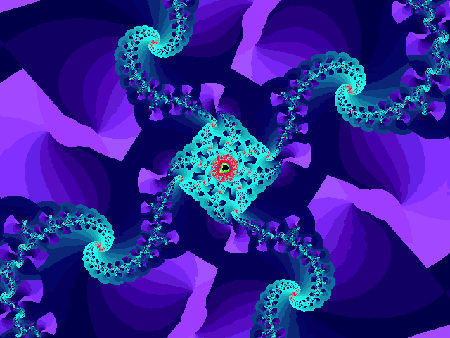
Challenging Midget by Jim Muth
Fractal of the Day: 1-13-01
Fractal visionaries and enthusiasts:
A few days ago I received an e-mail from a fractal fan, asking me to tell more about fractals. Since I had no idea of where 'more' started, I didn't know quite what to tell. But once I sat at my keyboard this morning to reply to the e-mail, the philosophical muses came to life, and the words flowed almost of their own accord. The following four paragraphs are a slight revision of the letter I sent earlier today. Perhaps the philosophy is once again ready to arise.
My interest in fractals is mathematical, artistic, and philosophical. Mathematically, fractals are simply graphs of iterated mathematical functions. Artistically, fractals offer a means of expressing one's artistic aspirations, though I consider the importance of this aspect to be somewhat exaggerated. My main interest lies in the philosophical aspect of fractals.
Perhaps the question most often asked about fractals is, "what are they?" In addition, I often wonder, "are fractals real?" The answer can only be, "fractals are the things numbers do, and numbers are pure abstractions". The Mandelbrot set does not exist in the sense that a tree does. No one will ever find a 'real' Mandelbrot set; they will find only pictures of it. The M-set exists only because human beings evolved with the sense of vision, and to better understand the workings of math functions, find it helpful to turn the functions into pictures. In essence, the Mandelbrot set exists only because we created it with our minds and sustain it with our computers.
Much is also made of the fractal nature of the real world. We hear about the fractal nature of trees, ferns, clouds, coastlines, etc. These things do indeed have a fractal surface appearance, but they are not true fractals in the mathematical sense. A true mathematical fractal continues unchanged to infinity regardless of how much it is magnified. The 'real world' fractal objects such as trees and clouds ultimately break down into individual cells and water droplets, and finally into atoms, which no one shall ever observe directly.
But according to quantum theory, atoms also are nothing more than convenient pictures, models created in human minds from mathematical functions. And I have heard it said that numbers themselves are creations of the human mind. So is the 'real world' the world's greatest fractal? The answer to this challenging question is what I am currently seeking.
[...]
The fractal weather today here at Fractal Central was once again comfortable, though not nearly as mild as yesterday. The partly sunny skies and temperature of 42F (5.5C) lured the fractal cats onto the porch and into the yard, but once in the yard they quickly decided it was a bit too chilly, and soon returned to their radiators.
And this leaves me with nothing to do but shut down the fractal shoppe and call it a night. I'll watch a junky old movie if I can stay awake. Until tomorrow, take care, and beware of the fractal witch.
Is the real world the world's greatest fractal? I don't know, Jim. It's certainly filled with chaos, isn't it? And we, as a species, seem to keep making the same self-similar mistakes over and over again. And the fractal (art?) images I create seem to come from something I've seen in my head -- and these images seem to say something about the world as I see it. They do seem to be models of mental pictures that started with mathematics. And what is art if not the world according to its creator?
Goodnight, Jim. I'll take first watch tonight to keep an eye out for that fractal witch. I hope the fractal weather stays nice and the fractal cats stay warm. And you take care, too, okay? Watch that bad movie, if you can ward off the Sandman, and sleep well. And, soon, I, and all of us, will see you again tomorrow...
Hat tip for this post to PNL.
Tags: fractal, fractals, fractal art, fractal blog, fractal cats, fractal of the day, jim muth, fotd, original fractal blogger, art vs math, desecration for art and profit, paul n lee, cruelanimal, orbit trap
